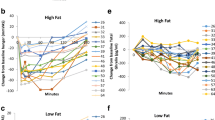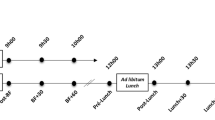Abstract
The human hunger sensation (HS) is a perceptive signal characterized by day-night variability (DNV). This pattern was investigated with respect to its relations with the body compartments in 22 clinically healthy subjects (CHS, 11 males and 11 females mean age: 24±2.5 years, mean BMI: 21±1.7). The DNV was investigated by means of con ventional descriptive statistics and the single cosinor method (SCM). Both procedures were applied to the orexigram, i.e., the 24-h profile of the orectic stimulus (OS) provided by each subject, who self-rated his/her HS (from 1 to 10 hunger units) every half hour. Body composition was investigated by Bioelectrical Impedance Analysis (BIA) on the day when the orexigrams were compiled. It was found that the daily HS level correlates positively with the Free Fat Body Mass (FFBM) and negatively with the Fat Body Mass (FBM). These opposite relations indicate that HS is stimulated by the needs of the FFBM, and inhibited by expansion of the FBM, and provide further evidence of the existence of an “adipostat anorectic mechanism.
Similar content being viewed by others
References
Cugini P., Murano G., Lucia P., Mazzetti di Pietralata M.: Circadian and ultradian rhythms for hunger behaviour. In: Ferrari E., Brambilla F. (Eds.), Disorders of eating behaviour. A psychoneuroendocrine approach. Advances in the biosciences, Oxford, Pergamon Press, 1986, Vol. 60., pp. 93–96.
Cugini P., Battisti P., Di Palma L.: Eating behaviour: investigation on the recursive components of hunger sensation by iterative rhythmometry. Ital. J. Gastroenterol., 23, 128–131, 1991.
Cugini P., Battisti P., Di Palma L., Di Stasio E.M., Paggi A., De Luca A., Ciamei A., Ferrari, E.: Spectral analysis of hunger sensation in obese patients provides evidence for three subtypes, namely eurectic, hyperrectic and hyporectic obesity. In: Proceedings of the 2nd International Symposium on “Disorders of Eating Behaviour”. Pavia, September 15–19, 1992. Advances in the Biosciences, Oxford, Pergamon Press., 1993, Vol. 90., pp. 393–396.
Cugini P., Battisti P., Paggi A., Di Stasio E.M., Di Palma L., Morelli F., Pisculli M., Lavielle R.: Chronobiometric identification of disorders of hunger sensation in essential obesity: thera-peutic effects of dexfenfluramine. Metabolism, 44, 50–56, 1995.
Cugini P., Battisti P., Di Palma L., Ferrari E.: Spectral analysis to explore hunger sensation in obesity. Chronobiol. Section, 1, 37–44, 1995.
Cugini P., Fatati G., Paggi A., Coaccioli S., Paci F., Palazzi M., Puxeddu A.: Hunger sensation in patients with compensated and uncompensated type 1 and type 2 diabetes mellitus. Int. J. Eating Disord., 20, 85–98, 1996.
Cugini P., Battisti P., Paggi A., Di Stasio M.E.: Twenty-four-hour pattern of hunger sensation in obesity complicated by type 2 diabetes mellitus: a pattern recognition by spectral analysis. Metabolism, 45, 1342–1347, 1996.
Heymsfield S.B., Waki M.: Body composition in humans: advances in the development of multicompartment chemical models. Nutr. Rev., 49, 97–108, 1991.
Segal K.R., Gutin B., Presta E., Wang J., Van Itallie T.B.: Estimation of human body composition by electrical impedance methods: a comparative study. J. Appl. Physiol., 58, 1565–1571, 1985.
Segal K.R., Van Loan M., Fitzgerald P.I., Hodgon J.A., Van Itallie T.B.: Lean body mass estimation by bioelectrical impedance analysis: a four-site cross-validation study. Am. J. Clin. Nutr., 47, 7–14, 1988.
Segal K.R., Burastero S., Chun A., Coronel P., Pireson R., Wang J.: Estimation of extracellular and body water by multiple-frequency bio-electrical impedance measurement. Am. J. Clin. Nutr., 54, 26–29, 1991.
Kushner R.F., Schoeller A.D.: Estimation of total body water by bioelectrical impedance analysis. Am. J. Clin. Nutr., 44, 417–424, 1986.
Van Loan N., Mayclin P.: Bioelectrical impedance analysis: is it a reliable estimator of lean body mass and total body water. Am. J. Hum. Biol., 59, 299–309, 1987.
Jackson A.S., Pollock M.L., Graves J.E., Mahar M.T.: Reliability and validity of bioelectrical impedance in determining body composition. J. Appl. Physiol., 64, 519–534, 1988.
Shizgal H.M.: Validation of the measurement of body composition from whole bioelectric impedance. Surg. Forum., 39, 67–74, 1988.
Deurenberg P.: International consensus con-ference on impedance in body composition. Age & Nutrition, 5, 142–145, 1994.
Ross R., Legger L., Martin P., Roy R.: Sensitivity of bioelectrical impedance to detect changes in human body composition. J. Appl. Physiol., 67, 1643–1647, 1989.
Halberg F., Johnson E.A., Nelson W., Runge W., Sothern R.B.: Autorhythmometry: proce-dures for physiologic self-measurements and their analysis. Physiol. Teach., 1, 1–11, 1972.
Considine R.V., Caro J.F.: Leptin and the regulation of body weight. Int. J. Biochem. Cell. Biol., 29, 1255–1272, 1997.
Ahren B., Larsson H., Wilhelmsson C., Nasman B., Olsson T.: Regulation of circulating leptin in humans. Endocrine, 7, 1–8, 1997.
Perry H.M. 3rd, Morley J.E., Horowitz M., Kaiser F.E., Miller D.K., Wittert G.: Body composition and age in African-American and Caucasian women: relationship to plasma leptin levels. Metabolism, 46, 1399–1405, 1997.
Shillabeer G., Vydelingum S., Hatch G., Russell J.C., Lau D.C.: Long-term regulation of leptin expression is correlated with adipocyte number in obese rats. Clin. Invest. Med., 21, 54–62, 1998.
Stephens T.W., Caro J.F.: To be lean or not to be lean. Is leptin the answer? Exp. Clin. Endocrinol. Diabetes, 106, 1–15, 1998.
Xu B., Dube M.G., Kalra P.S., Farmerie W.G., Kaibara A., Moldawer L.L., Martin D., Kalra S.P.: Anorectic effects of the cytokine, ciliary neurotropic factor, are mediated by hypothalamic neuropeptide Y: comparison with leptin. Endocrinology, 139, 466–473, 1998.
Friedman J.M.: Leptin, leptin receptors, and the control of body weight. Nutr. Rev., 56, s38–s46, 1998.
Author information
Authors and Affiliations
Rights and permissions
About this article
Cite this article
Cugini, P., Salandri, A., Cilli, M. et al. Daily hunger sensation and body composition: I. Their relationships in clinically healthy subjects. Eat Weight Disord 3, 168–172 (1998). https://doi.org/10.1007/BF03340006
Published:
Issue Date:
DOI: https://doi.org/10.1007/BF03340006




